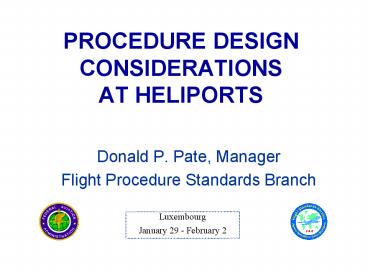PROCEDURE DESIGN CONSIDERATIONS AT HELIPORTS - PowerPoint PPT Presentation
1 / 46
Title:
PROCEDURE DESIGN CONSIDERATIONS AT HELIPORTS
Description:
Safety improvement - avoid 'scud running' Lack of IFR helicopter infrastructure results in continued ... Lack of heliports that are compliant with IFR ... – PowerPoint PPT presentation
Number of Views:355
Avg rating:3.0/5.0
Title: PROCEDURE DESIGN CONSIDERATIONS AT HELIPORTS
1
PROCEDURE DESIGN CONSIDERATIONS AT HELIPORTS
- Donald P. Pate, Manager
- Flight Procedure Standards Branch
Luxembourg January 29 - February 2
2
OVERVIEW
- Introduction
- Background
- Status
- Helicopter/Avionics Requirements
- What is Ahead?
3
INTRODUCTION
- Move helicopter operations from VFR to IFR
infrastructure - En Route
- Terminal
- Heliport Instrument Procedures
- Safety improvement - avoid scud running
- Lack of IFR helicopter infrastructure results in
continued visual operations in very low ceilings
and visibilities
4
INTRODUCTION(CONTINUED)
- Significant infrastructure issues
- Lack of heliports that are compliant with IFR
standards - ATC handling
- Need for lower minimum en route altitudes
- Lack of airspace NOTAM system
5
INTRODUCTION(CONTINUED)
- Other factors that complicate transition
- Heliport lighting standards
- Icing
- Often only one way in and out
- Advent of GNSS made it imperative to address
issues - Primary user of heliport instrument procedures
into VFR heliports
6
WHAT WAS DONE
- Specialized program to begin transition
- Developed policy for heliport IFR operations
- Point-in-Space procedures
- Must proceed visually or VFR from MAP
- Procedures are normally special procedures
- Not available to public (specific operator only)
- Training requirements
- Equipment requirements
- Funding
- FAA quality controlled
7
WHAT WAS DONE(CONTINUED)
- Qualification of Non-IFR Heliports
- State certification
- On-site heliport standards evaluation
- On-site approach specific evaluation
- Visual segment profile tailored to heliport
- Required training on heliport environment
- Plan for ongoing obstruction evaluation
- Plan for approach procedure maintenance
- Plan for operator notification
- Plan for periodic flight inspection
8
WHAT WAS DONE(CONTINUED)
- United States policy characteristics
- Very controlled
- Most are special procedures
- Specific structured plan to address long-term
transition issues
9
BACKGROUND
- GPS nonprecision approach criteria
- Worked with EMS operators
- Determined what flightcrews expected
- Operators aircraft and crews used
- Flight data collection
- Used very accurate (sub-meter) post-processed
differentially corrected GPS sensors - Flight test results used to develop criteria
- More than 130 point-in-space EMS helicopter
procedures currently in use
10
EN ROUTE SEGMENTS
11
GPS EN ROUTE IFR SEGMENT
12
TERMINAL SEGMENTS
13
BASIC T CONFIGURATIONTERMINAL AREA
14
Helicopter GPS Minimum Segment Lengths and
Descent Gradients
15
Final Segment
16
VISUAL SEGMENTS
17
Requirements for Special PINS Approaches
- Procedure annotated Proceed Visually to
Landing Site - Course change must not exceed 30
- Minimum visibility not less than the MAP to
heliport distance - All obstacles penetrating the obstacle
identification surface (OIS) should be lighted
and must be charted - If procedure is unusable at night, it must be
annotated Procedure NA at Night
18
(No Transcript)
19
VISUAL SEGMENT WITH TURN
20
VSDA and OIS
21
VSDA and OIS
22
MAP More Than 10,500 Feet to the Heliport
23
Special Point-in-Space Area within 30 NM of the
HRP
24
LNAV/VNAV
25
(No Transcript)
26
DEPARTURES
- Diverse
- Sector
- Route
- Point-in-Space (PINS)
- Special PINS
27
DIVERSE DEPARTURE
28
Sector Departure
29
ROUTE DEPARTURE
30
Requirements for Special PINS Departures
- Perform an approach RAIM prediction for the
departure time - Set CDI sensitivity to 0.3 NM full-scale
deflection - Perform a position verification check with the
helicopter over the FATO center - Must proceed visually until obtaining minimum IDF
crossing altitude
31
DEPARTURE CLIMB OIS
32
HOVER CLIMB TO AVOID OIS PENETRATION
33
Gulf Helicopter Operations
- 3.8 Million Passengers (1997)
- 4,671 Flights Per Day
- Fleet -636 helicopters
34
(No Transcript)
35
EN ROUTE CRITERIA
36
OFFSHORE STANDARD APPROACH PROCEDURES (OSAP)
37
(No Transcript)
38
OFF SHORE APPROACH PROCEDURE (OSAP) PROCEDURE
CHART
39
HEDA
40
SBAS (WAAS)
41
Helicopter/Avionics Requirements
- Lessons learned in precision approaches to
heliports. If approach minimums are to be
beneficial, several factors must be considered. - Minimum visibility not less than the MAP to
heliport distance - Maximum ground speed of 70 knots
- Ground speed available from GNSS sensor
- Helicopter requires a certified Vmini
42
Helicopter/Avionics Requirements (CONTINUED)
- Helicopter must be certified for steeper approach
angles, e.g., 6 to 7.5 - Deceleration distance must be protected
- Distance from DA to heliport critical
- Requires Vmini or higher airspeed at DA and stop
above heliport (airplanes land and then stop
helicopters must stop and then land) - Descent Point (DP) prompt needed
43
DECISION POINT CONCEPT
44
WAAS (SBAS) AVIONICS ISSUES
- MOPS RTCA DO-229B has helicopter/heliport
appendix - Display scaling
- GPA/3 degrees (helicopters) vs GPA/4 degrees
(airplanes) - 3/6 degrees lateral full scale
- DP annunciation requirement
45
United States Future Plans
- Establish GPS Low Altitude En Route Standards
- Develop LAAS Heliport Criteria
- Develop Standards for Simultaneous
Non-interfering Operations - Develop IFR Heliport Lighting Requirements
46
United States Future Plans(CONTINUED)
- Complete IFR Heliport Standards and
Infrastructure - Complete WAAS Standards and Implement
- Complete Approval Standards for Lower than 200 ft
DA Operations on ILS - Complete LNAV/VNAV Data Collection and Establish
Criteria































